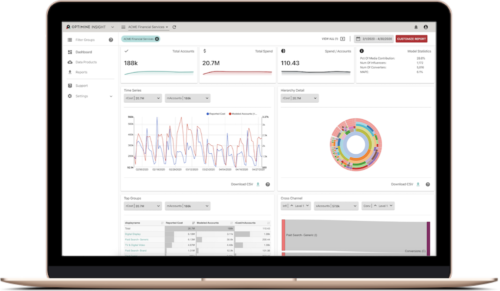How to Measure Cross-Channel Marketing
01/22/2024
In the dynamic landscape of modern marketing, measuring cross channel strategy effectiveness is imperative for brands seeking to thrive in a multichannel environment. In OptiMine’s latest blog post, we delve into the intricacies of cross-channel marketing and offer a comprehensive guide on how to measure cross-channel marketing while exploring its benefits and challenges. Let’s get started!
What is Cross-Channel Marketing?

Cross-channel marketing refers to a strategic approach of integrating and coordinating marketing efforts across multiple channels and platforms to deliver a cohesive and consistent brand message. In today’s interconnected digital landscape, brands must leverage a variety of channels such as social media, email, websites, mobile apps, and traditional advertising to effectively reach and engage with their customers. Cross-channel marketing aims to create a seamless and unified experience for consumers, ensuring they receive a consistent brand message regardless of the channel.
This approach recognizes the diverse ways in which consumers access information and make purchasing decisions, emphasizing the importance of a harmonized and synchronized marketing strategy across all touchpoints to maximize impact and enhance overall customer experience. Through cross-channel marketing, businesses can build stronger connections with their audience, increase brand awareness, and drive more effective and personalized communication.
The Benefits to Measuring Cross-Channel Data
Measuring cross-channel data offers several significant benefits for brands:
- Holistic insight: Cross-channel data measurement provides a comprehensive view of customer interactions across various touchpoints. This holistic insight allows brands to understand the customer journey more accurately, identifying patterns and trends that may be missed when looking at individual channels in isolation.
- Optimized marketing strategies: Analyzing cross-channel data helps marketers identify which channels are most effective in reaching and engaging their target audience. This information enables them to allocate resources more efficiently, optimizing marketing strategies to focus on the channels that yield the best results.
- Improved customer experience: By measuring data across channels, brands can ensure a consistent and seamless customer experience. Understanding how customers move between channels allows for better integration of marketing efforts, providing a more cohesive and personalized experience for the consumer.
- Enhanced targeting and personalization: Analyzing cross-channel data enables brands to create more accurate customer profiles. This, in turn, facilitates better targeting and personalization of marketing messages, increasing the relevance of communication and improving the chances of customer engagement.
- Cost efficiency: Understanding the performance of each channel allows brands to identify cost-effective marketing strategies. By eliminating or optimizing underperforming channels, companies can achieve better cost efficiency and maximize their return on investment (ROI).
- Real-time adjustments: Cross-channel data measurement enables brands to make real-time adjustments to their marketing campaigns. If certain channels are not performing as expected or if new opportunities arise, marketers can adapt their strategies quickly to stay agile and responsive in the dynamic marketing landscape.
- Data-driven decision making: Measurement of cross-channel data promotes a data-driven decision-making culture within an organization. By relying on concrete data and analytics, businesses can make informed strategic decisions, reducing the reliance on intuition and guesswork.
The Challenges with Analyzing Cross-Channel Data
There are also some challenges that come with analyzing cross-channel data, mainly due to the complexity and diversity of data sources. Here are some common challenges associated with cross-channel data analysis:
- Data integration issues: Combining data from various channels can be challenging, especially when dealing with different formats, structures and sources. Inconsistent data formats or incompatible systems may hinder the seamless integration of information, making it difficult to obtain a unified view.
- Privacy and compliance concerns: Analyzing cross-channel data requires careful consideration of privacy regulations and compliance standards. Ensuring the analysis and use of customer data adhere to legal requirements, such as GDPR or CCPA, adds an extra layer of complexity to the process (which is easy if you’re using a privacy-safe measurement solution like OptiMine!)
- Attribution complexity: Determining the attribution of conversions or sales to specific channels is complex. Customers may interact with multiple channels throughout their journey, and assigning the appropriate weight to each touchpoint requires advanced modeling. This complexity can make it challenging to accurately assess the impact of each channel on overall performance.
- Data silos: Organizations often store data in separate silos, each dedicated to a specific channel or department. This fragmentation can lead to a lack of centralized visibility, making it challenging to analyze data comprehensively and derive meaningful insights across channels.
- Resource intensiveness: Comprehensive cross-channel analysis often requires significant resources, including advanced analytics tools, skilled personnel, and computing power. Small and medium-sized businesses may face challenges in allocating these resources effectively.
- Consistent metrics and KPIs: Standardizing metrics and key performance indicators (KPIs) across different channels is crucial for meaningful analysis. However, variations in how channels measure and report data can lead to discrepancies and make it difficult to compare performance accurately.
- Understanding customer behavior across channels: Gaining a deep understanding of how customers move between channels and the impact of each interaction on their behavior is a persistent challenge. Customer journeys are increasingly complex, and accurately mapping these journeys requires sophisticated analytics.
- Adapting to emerging channels: The digital landscape is dynamic, with new channels and platforms constantly emerging. Adapting cross-channel analysis strategies to include these new channels presents a challenge, as businesses must stay agile and responsive to changes in consumer behavior.
How to Measure Cross-Channel Marketing

Measuring cross-channel marketing involves a systematic approach to gather, integrate, and analyze data from various marketing channels. Here are the key steps to effectively measure cross-channel marketing:
1. Define Objectives and Key Performance Indicators
- Clearly define your marketing objectives and identify the Key Performance Indicators (KPIs) that align with these goals.
- Establish measurable metrics for each marketing channel, considering factors such as brand awareness, customer engagement, conversions, and return on investment (ROI).
2. Implement Tracking and Analytics Tools
- Set up robust tracking and analytics tools to collect data from each marketing channel.
- Ensure that tracking codes, pixels, or other (privacy-compliant) mechanisms are correctly implemented on your website and other relevant platforms.
3. Integrate Data Sources
- Integrate data from different channels into a centralized data repository. This may involve using marketing analytics platforms, customer relationship management (CRM) systems, or other data integration tools (such as OptiMine).
- Aim for a unified and consistent dataset that provides a holistic view of customer interactions across channels.
4. Normalize Data
- Normalize data to ensure consistency across channels. This involves standardizing metrics, timeframes, and other relevant variables for accurate and meaningful comparisons.
- Address any discrepancies in how data is collected and reported across different channels.
5. Conduct Cross-Channel Analysis
- Analyze data across channels to identify patterns, trends, and correlations. Look for insights that can inform marketing strategy and decision-making. Fun fact: OptiMine’s measurement solution can measure ALL the channels, making this step easy for your brand!
- Consider conducting A/B testing or multivariate testing to assess the impact of specific changes or variations in your marketing approaches.
6. Generate Reports, Dashboards and Action Oriented Insights
- Create reports and dashboards that present key performance metrics and insights in a visually accessible format.
- Regularly review and update these reports to track changes in performance over time and across channels.
- After review, leverage your new learnings to identify optimizations to further drive the defined KPIs.
7. Iterate and Optimize
- Continuously iterate and optimize your cross-channel marketing strategy based on the insights gained from data analysis.
- Test new approaches, allocate resources based on channel performance, and adapt to changes in the marketing landscape.
By following these steps, brands can develop a robust framework for measuring cross-channel marketing, enabling them to make data-driven decisions and enhance overall marketing effectiveness.
How OptiMine Makes Measuring Cross-Channel Performance Easy

Overwhelmed thinking about the workload that comes with developing and executing all of the steps laid out above? Don’t worry, OptiMine is here to help! OptiMine provides the fastest, most actionable cross-channel measurement for all digital and traditional marketing across any online and offline conversion points – and is 100% privacy-safe. Contact us today to learn more about how we can guide your brand to cross-channel measurement success!

